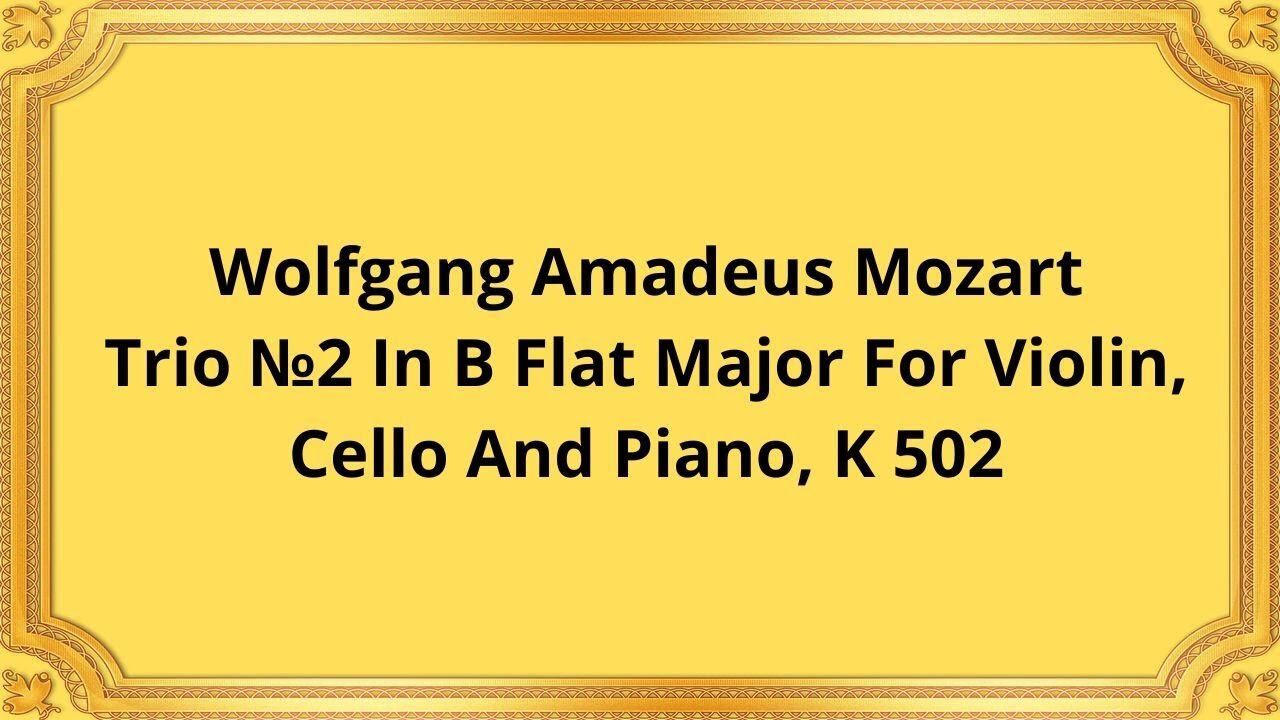Premium Only Content

Wolfgang Amadeus Mozart Trio №2 In B Flat Major For Violin, Cello And Piano, K 502
#classicalmusic #WolfgangAmadeusMozart #TrioNo2 #BFlatMajor #Violin #Cello #Piano #MusicalComposition #MozartTrio #ClassicalComposers #MusicHistory #ClassicalEnsemble #ChamberMusic #MozartInfluence #MozartLegacy #MusicPerformance #MozartTrioNo2
Jean Fournier; Antonio Janigro; Paul Badura-Skoda;
Wolfgang Amadeus Mozart, a prodigious talent of the Classical era, left an enduring legacy in the world of music through his remarkable compositions. Among his vast array of works, Mozart's Trio No. 2 in B Flat Major for Violin, Cello, and Piano, K 502, stands as a testament to his genius.
Composed in 1786, during the height of Mozart's prolific career, Trio No. 2 in B Flat Major reflects the elegance and refinement of the Classical era. Mozart, a prolific composer and child prodigy, played a pivotal role in shaping the musical landscape of his time. This period witnessed a shift from the elaborate Baroque style to a more balanced and structured approach characterized by clarity, grace, and emotional depth.
Mozart's Trio No. 2 in B Flat Major is a masterclass in chamber music composition. It consists of four movements – Allegro, Larghetto, Menuetto, and Allegretto. The opening Allegro immediately engages the listener with its lively and spirited melodies, showcasing Mozart's gift for crafting memorable musical motifs. The Larghetto is a heartfelt and lyrical movement, allowing for moments of introspection and emotional depth. The Menuetto, a graceful dance-like movement, provides a delightful contrast. The Finale: Allegretto, marked by its energetic and playful character, concludes the trio with virtuosic passages and lively interplay between the instruments.
In this trio, Mozart expertly balances the roles of the violin, cello, and piano. The violin carries the melodic lines with its brilliant and expressive voice, while the cello provides a rich and resonant bassline. The piano acts as both a harmonic support and a soloistic instrument, showcasing Mozart's mastery of writing for the keyboard. The interplay between the three instruments creates a harmonious and cohesive ensemble, with each instrument contributing to the narrative of the music.
Mozart's Trio No. 2 in B Flat Major continues to captivate audiences and musicians alike with its timeless elegance and profound musicality. Its melodic beauty, technical brilliance, and meticulous compositional structure have ensured its place among the chamber music repertoire. This composition not only showcases Mozart's exceptional talent but also represents the epitome of the Classical style.
The Trio No. 2 in B Flat Major remains a testament to Mozart's enduring influence on the world of music. Its enduring appeal and widespread popularity have made it a staple of concert halls and chamber music ensembles. This composition stands as a testament to Mozart's genius and his ability to create music that transcends time and touches the hearts of listeners.
Conclusion:
Wolfgang Amadeus Mozart's Trio No. 2 in B Flat Major for Violin, Cello, and Piano, K 502, stands as a testament to his unparalleled musical genius. Its historical significance, exquisite musical elements, and enduring appeal make it a cherished composition in the chamber music repertoire. Through this trio, Mozart's brilliance shines, leaving us in awe of his ability to create enchanting and timeless music. The Trio No. 2 in B Flat Major continues to inspire and captivate listeners, reminding us of the eternal beauty and power of classical music.
You have the opportunity to support the channel:
https://destream.net/live/RadSiarAl/donate
https://www.buymeacoffee.com/6355radsiaral
-
 48:22
48:22
Classical music_Music Inspiration
1 month agoHector Berlioz Fantastic Symphony
681 -
 LIVE
LIVE
Wendy Bell Radio
6 hours agoSH*T Is About To Get Real
9,538 watching -
 4:01:10
4:01:10
The Bubba Army
1 day agoGhislaine Maxwell: Ready to TALK?! - Bubba the Love Sponge® Show | 7/15/25
203K15 -
 9:16
9:16
Zoufry
23 hours ago $3.57 earnedThe Evil Design of Mcdonald's Drive Thru
32.6K19 -
 LIVE
LIVE
GritsGG
3 hours agoWe Are Winning Every Game!!!! Most Wins 3040+! 🔥
99 watching -
 1:57:28
1:57:28
Gary Cardone
2 days ago $3.00 earnedLIVE With Gary Cardone
31.3K4 -
 8:01
8:01
MattMorseTV
21 hours ago $14.00 earnedTrump just DROPPED a BOMBSHELL.
99.1K90 -
 LIVE
LIVE
FyrBorne
13 hours ago🔴Warzone M&K Sniping: Is The Overlook OP or Bait?
212 watching -
 2:00:53
2:00:53
MG Show
1 day agoTrump Stops the Epstein Nonsense & Exposes FAKE MAGA; Victory Lap
125K97 -
 39:21
39:21
MattGaetz
1 day agoThe Anchormen Show with Matt Gaetz | Feeding the Dragon
54.6K28